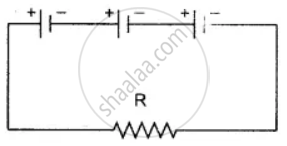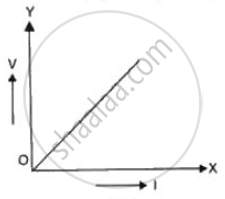Advertisements
Advertisements
प्रश्न
Illustrate-combination of cells e.g., three cells, in series, explaining the combination briefly. Obtain an expression for current ‘i’ in the combination.
उत्तर
Combination of cells in series:

In this combination, the cells are so connected that the negative terminal of one cell is connected to the positive terminal of the other cell such that in the end one free positive and one free negative terminal are left. These free terminals are connected to the external circuit. If the e.m.f of each cell is E and Y be the internal resistance and I be the current, then e.m.f. of the cell in series = nE (here n = 3)
The total internal resistance = nr
and External resistance = R
∴ Current I in the external circuit `= "Total e.m.f."/"Total resistance of the circuit"`
I = `"nE"/"nr + R"`
If r is very small, then neglecting r, we get I = `"nE"/"R"`
This shows that it is advantageous to connect cells in series to get a large current when their internal resistance is negligible.
APPEARS IN
संबंधित प्रश्न
In series combination which remains constant?
(a) Voltage
(b) Current
(c) Both current and voltage
(d) Both are variables
Complete the following :-
(a)

A battery of 9 V is connected in series with resistors of 0.2 Ω, 0.3 Ω, 0.4 Ω, 0.5 Ω and 12 Ω, respectively. How much current would flow through the 12 Ω resistor?
In series combination of resistances ______.
A graph is plotted taking p.d. along y-axis and electric current along x-axis. Name the physical quantity that represents the slope of this graph (Fig.).

What potential difference is needed to drive a current o f 1 A through a 5 Ω resistor?
When do you say that the resistors are connected in this way? Draw a circuit diagram.
A given metallic wire of resistance R is doubled on itself. What will be its new resistance?
How does the resistance of an alloy, vary with temperature?
How does the resistivity of an alloy such as constantace depends on temperature.
